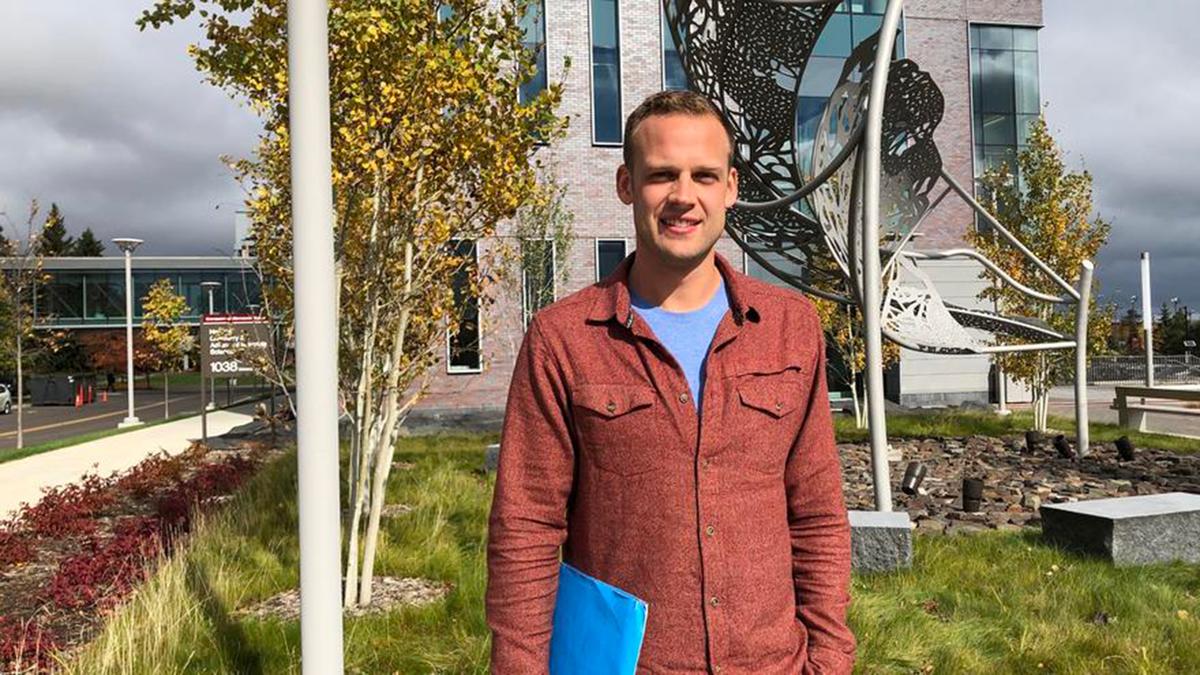The Heikkila Chemistry and Advanced Materials building stands tall on the southwest edge of UMD’s campus. High glass windows let in the sunshine as students and faculty cross the skywalk to attend class or work in research labs. It was built with sustainability in mind and designed to house the Chemistry Department and the newly added Advanced Materials Center. The building is a symbol of a bridge between engineering and science. It is the latest edition to campus and plays a role in the debut of UMD’s newest master’s program: Applied Materials Sciences.
“The program is a fusion of physics, material science, chemistry, and engineering,” says graduate student John Fox. “It’s an interdisciplinary approach to the study and use of different materials.”
In Fall 2019, UMD launched the core classes, bringing first-year students on a journey through all the different materials they might encounter. These materials cover an expansive range of materials from metals and alloys to ceramics and polymers.
Polymers of the Past
Polymer research at UMD has already made a significant impact. In 2008, UMD and chemistry Professor Robert Carlson’s research group entered a joint research-development agreement with UMD alumnus Kurt Heikkila’s company, Tundra, to develop new polymer-based materials as lead substitutes in product applications.
The UMD group developed particle coatings that allowed for a high density of metal particles to be incorporated into polymer materials. The first successful applications were the use of metals other than lead in balancing tires (e.g., wheel weights), fishing lures, and ammunition. The result was a significant advancement in protecting the environment from heavy metal contamination. Other applications have rapidly followed.
Today, the Heikkila Chemistry and Advanced Materials Science building, which is named for Kurt and Beth Heikkila, serves to honor these scientific advances and create an environment for future innovations.
For the Love of Chemistry
Like Kurt Heikkila and Robert Carlson, John’s passion is chemistry. “It was organic-chem that got me hooked on chemistry,” he says.
He began his pursuit of chemistry as an undergraduate at Carleton College. He was awarded a Snyder Scholarship to complete a summer Research Experience for Undergraduates program (REU). He worked at the University of Illinois under Dr. Scott E. Denmark, a professor in organic chemistry who has won several awards for his work in synthetic reactions.
“It was an intense experience,” he says. “I really liked organic chemistry but I wasn’t quite sure about synthetic research.”
John was also presented with several opportunities after graduation. He worked as a medical scribe, he traveled to Ecuador twice, and he was accepted to medical school. But there was something about medical school that didn’t quite feel right.
John contacted Dr. Mary Christiansen, the director of graduate studies for the Applied Materials Sciences program. He was excited about UMD and jumped on the opportunity to use a variety of instrumentation. He liked the idea of doing targeted research to solve a specific problem, and even made a wishlist of instruments he was interested in learning.
“I want to solve a novel problem. Or try to solve a novel problem and fail,” says John, “What’s important is having the opportunity to try, and then continuing to try again and again.”
A Project on Polymers
A major part of the M.S. in Applied Materials Sciences is the completion of a research project. Excited to launch into his project, John is working with Dr. Melissa Maurer-Jones as his research advisor and plans to study the degradation of plastics found in the environment.
When plastic enters our environment, like the plastic waste that ends up in our lakes and ocean, the plastic molecules, called polymers, are changed by environmental factors such as sunlight. These molecular changes can cause the physical or mechanical properties of the plastics to change too, like causing microplastics to form.
John is excited to start his project. He is going to use a process called Fourier-transform infrared spectroscopy, or FTIR, to look for changes in the polymer molecules. “Each molecule is made up of atoms held together by bonds,” says John. John will use FTIR to look for signals from the bonds within the polymer and how the bonds change as the plastic is degraded.
Understanding polymer degradation is an important topic in environmental and analytical chemistry because of the wide use of plastics and how many enter our environment. This project could have major implications for natural water systems. John is itching to find out.
About the Advanced Materials Center
About the Master of Science in Applied Materials Sciences
Photo above: John Fox
This story was written by UMD University Marketing & P.R. student employee, Nora Curtis, a biology major with a minor in professional writing.
